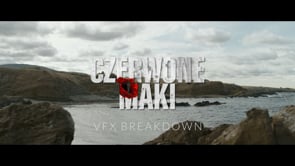Red Poppies / Czerwone Maki (2024) is the biggest Polish war movie of recent years. It tells the story of the Battle of Monte Cassino – a series of brutal assaults by the Allies, led by Polish troops, against the Winter Line in Italy held by Axis forces during World War II, from January to May 1944.
Imaginary Pixels, a VFX vendor from Poland, was responsible for producing VFX for over 120 shots, that required creating and animating 3D tanks, 3D set extensions, FX simulations, 3D creature animation, crowd duplication and compositing.
It’s also worth mentioning that open source software, like Blender and CGWire Kitsu, was used for the VFX production.
An extensive article describing the interesting and challenging parts of creating VFX for this movie is available at the studio’s website: VFX production of Red Poppies
Creating digital creatures
Most complex part of the VFX production involved creating and animating a 3D version of Wojtek the bear, and replacing the on-set used dummy. Wojtek was a Syrian brown bear adopted by Polish soldiers during World War II. He became an unofficial member of the Polish II Corps, helping to boost the morale of the troops. Wojtek became famous for his role in the Battle of Monte Cassino, where he helped move ammunition by carrying artillery shells. To allow him to travel with the soldiers, he was officially enlisted as a private and later promoted to corporal. Wojtek’s story symbolized camaraderie and resilience among the soldiers.
During the development of this CG creature, a lot of time was spent on the hair system and the look of the fur, which is very unique for Syrian bears. Most of the shots with Wojtek required interaction with actors, so the hair system needed to dynamically respond to collisions when an actor touched him. Blender’s particle system was used to create the fur. It was separated into multiple different particle systems (head, body, neck, etc.) for more control.
One of the more challenging tasks was rotomating the actor’s arm and adding a 3D hand on top of it, to be used as fur collider. After tracking, the collisions were baked into the fur. Following several iterations on how the fur interacts with collisions and gravity, the final baking worked without many problems.
Creature animation
For animating the bear, the on-set dummy helped establish the base animation, which was then tweaked further depending on the interactions. A skin simulation was added on top of the animation to make the movement more natural, accounting for the bear’s skin being affected by gravity and movements. While watching reference footage of bears, the team was surprised how some bear movements, especially when standing on two feet, feel like a man in a suit
For the skin around the mouth and ears, the rig had bones that were automatically calculated based on the bear’s movements. The aim was to achieve physically accurate movements without manual keyframes, resulting in better overall outcomes and a much faster workflow.









Add comment